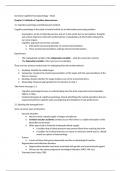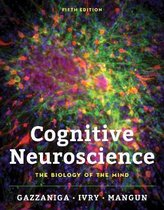Summary Cognitive Neuropsychology – Book
Chapter 3: Methods of Cognitive Neuroscience
3.1 Cognitive psychology and behavioural methods
Cognitive psychology is the study of mental activity as an information-processing problem.
- Assumption: we do not directly perceive and act in the world, but our perceptions, thoughts
and actions depend on internal transformations/ computations of information obtained by
our sense organs.
- Cognitive approach has two key concepts:
o Information processing depends on mental representations
o These mental representations undergo internal transformations
Experiments
- The manipulated variable is the independent variable – what the researcher controls
- The dependent variable is the event you’re evaluating
There are four primary mental tasks (in undergoing internal transformations)
1. Encoding. Identify the visible target
2. Comparing. Compare the mental representation of the target with the representations of the
items in memory
3. Deciding. Decide whether the target matches one of the memorized items
4. Responding. Respond appropriately for the decision in step 3
Take-home messages 3.1
- Cognitive psychology focuses on understanding how the brain represents and manipulates
objects or ideas
- Fundamental goals of cognitive psychology include identifying the mental operations that are
required to perform cognitive tasks and exploring the limitations in task performance
3.2 Studying the damaged brain
Some common types of disorders:
- Vascular disorders
o Neurons need a steady supply of oxygen and glucose
o Cerebral vascular accidents (strokes) occur when there is a sudden disruption of the
blood flow to the brain
o Other types lead to ischemia (inadequate blood supply)
A sudden drop in blood pressure may prevent blood from reaching the brain
A sudden rise in blood pressure can cause an aneurysm (weak spot in a blood
vessel) to rupture of haemorrhage
- Tumors
o A mass of tissue that grows abnormally and has no physiological function
- Degenerative and infectious disorders
o Degenerative disorder have been associated with genetic and environmental agents
o Viruses can also cause progressive neurological disorders (AIDS, HIV, etc.)
- Traumatic brain injury (TBI)
, - Epilepsy
o Characterized by excessive and abnormally patterned activity in the brain
Single and double dissociations
- Single dissociation: When a lesion to brain area X impairs the ability of a patient to do task A
but not task B, then we can say that brain area X and task A are associated, whereas brain
area X and task B are dissociated.
- Double dissociation: When damage to area X impairs the ability to do task A but not task B,
and damage to area Y impairs the ability to do task B but not task A.
o Identifies whether two cognitive functions are independent of each other (single
dissociation cannot do this)
Logic of studying participants with brain lesions: if a neural structure contributes to a task, then a
structure that is dysfunctional through either surgical intervention or natural causes should impair
performance of that task.
We have to associate neural structures with specific processing operations to see what is impaired.
This calls for appropriate control conditions. Most basic control is comparing with healthy
participants. The challenge for the cognitive neuroscientist is to determine whether the observed
behavioural problem results from damage to a particular mental operation or is secondary to a more
general disturbance.
A lesion may alter the function of neural regions that connect to it, either because the damage
deprives the regions of normal neural input or because synaptic connections fail, resulting in no
output. Lesions can also result in the development of compensatory processes.
Take-home messages 3.2
- Researchers study patients with neurological disorders or brain lesions to examine structure–
function relationships. Double dissociations are better evidence than single dissociations that
damage to a particular brain region may result in a selective deficit of a certain cognitive
operation.
- Traumatic brain injuries are the most common cause of brain lesions. Even when the injuries
are mild, they can have chronic neurodegenerative consequences.
- Impairments in a particular cognitive process do not mean that the damaged part of the brain
“performs” that process. Brain lesions can disrupt processing in intact brain structures or
disrupt brain networks on a larger scale.
3.3 Methods to perturb neural function
Many different drugs (psychoactive drugs) can disturb interactions in the brain, resulting in changes in
cognitive function.
Pharmacological studies may involve the administration of agonist drugs, those that have a similar
structure to a neurotransmitter and mimic its action, or antagonist drugs, those that bind to
receptors and block or dampen neurotransmission.
A major drawback of studies using drugs injected into the bloodstream is the lack of specificity.
Because the entire body and brain are awash in the drug, it is unknown how much of it actually
reaches the site of interest in the brain.
,A key methodology in exploring genetic components is to develop genetically altered animals using a
knockout procedure. Knockout, because the scientist manipulate a gene/set of genes so that it does
not express itself.
Given the risks associated with neurosurgery, researchers reserve invasive methods for studies in
animals and for patients with neurological problems that require surgical intervention. Direct neural
stimulation involves the placement of electrodes on or into the brain. These can be turned on and off.
This within-participant comparison provides a unique opportunity to investigate the link between
brain and behaviour.
Invasive stimulation methods
- Deep brain stimulation (DBS)
o A procedure in which surgeons implant electrodes in specific brain regions for an
extended period to modulate neuronal activity
- Optogenetics
o Provides a reliable switch to activate neurons using viral transduction
o Researchers attach a specific piece of DNA to a neural virus and allow the virus to
infect targeted cells with DNA
o Using optogenetic methods to turn cells on and off in many parts of the brain,
researchers can manipulate behaviour. This method has the twin advantages of
having high neuronal (or receptor) specificity, as well as high temporal resolution.
Noninvasive stimulation methods
- Transcranial magnetic stimulation (TMS)
o Produces relatively focal stimulation of the human brain noninvasively
o Various intensities, timings (single, repetitive, continuous) and frequencies possible
o Online (while participant is doing something) or offline (using protocols in which the
consequences of TMS are known to last well beyond the duration of the stimulation
itself)
o Depending on the protocol, the effects of stimulation either inhibit of enhance neural
activity
o Safe and noninvasive
o Can only activate relatively superficial areas
o Ability to induce “virtual lesions”
- Transcranial direct current stimulation (tDCS)
o Brain stimulation procedure that delivers a constant, low current to the brain via
electrodes placed on the scalp
o A current sent between two electrodes – an anode and a cathode
Neurons under the anode become depolarized
Achieve an elevated state of excitability
Neurons under the cathode become hyperpolarized
Pushed farther away from the threshold (less likely to fire)
o Poor spatial resolution
- Transcranial alternating current stimulation (tACS)
o Electrical current oscillates rather than remaining constant (tDCS)
o Experimenter can induce oscillations at specific frequencies, providing a unique
opportunity to causally link brain oscillations of a specific frequency range to
cognitive processes
, o Direction and duration of the effects can vary with the frequency, intensity, and
phase of stimulation (just like TMS)
- Limitations and new directions in noninvasive brain stimulation
o TMS, tDCS, tACS can serve as their own control
o They are safe methods
o tDCS, tACS, and to a lesser extent TMS all have poor spatial resolution, limiting the
ability to make strong inferences concerning mind–brain relationships
o Results have been somewhat inconsistent
This is because many other variables can influence the strength of the
electrical field (thickness of skull, layers of meninges, etc.)
Individuals vary in sensitivity to electrical stimulation
- Transcranial static magnetic stimulation (tSMS)
o Uses strong magnets to create magnetic fields that perturb electrical activity and
thus temporarily alter cortical function
o Inexpensive, does not require a skilled operator
- Transcranial focused ultrasound (tFUS)
o Has improved spatial resolution and the ability to target deeper structures
o Early work with this method has shown that tFUS can produce focal effects limited to
a 5-mm area.
Take-home messages
- Brain function can be perturbed by drugs, genetic manipulations, and magnetic or electrical
stimulation. In most cases, these methods allow the same participants to be tested in both
“on” and “off” states, enabling within-participant comparisons of performance.
- Genetic manipulations have played a major role in neuroscience studies using animal models.
Knockout technology enables scientists to explore the consequences of the lack of expression
of a specific gene in order to determine its role in behaviour. Optogenetic methods provide
the experimenter with the ability to control neuronal activity in targeted cells.
- Noninvasive stimulation methods perturb neural activity in healthy and neurologically
impaired humans. By varying the stimulation protocols, we can enhance or suppress neural
activity in targeted regions
3.4 Structural analysis of the brain
Methods that can image different structural properties of the brain:
- Computerized tomography (CT/CAT)
o First method to offer an in vivo look at the brain
o Constructs a 3D perspective from a series of thin-sliced 2D images
- Magnetic resonance imaging (MRI)
o Provides images with much higher resolution
o By systematically measuring the signals throughout the three -dimensional volume of
the head, an MRI system can construct an image based on the distribution of the
protons and other magnetic agents in the tissue
- Diffusion tensor imaging (DTI)
o Offers information about anatomical connectivity between regions
o DTI is performed with an MRI scanner that measures the density and the motion of
these water molecules and, taking into account the known diffusion characteristics of





